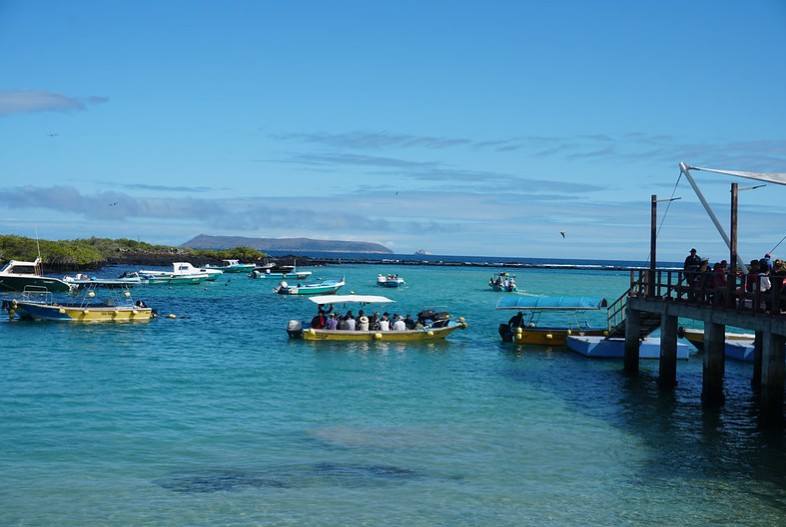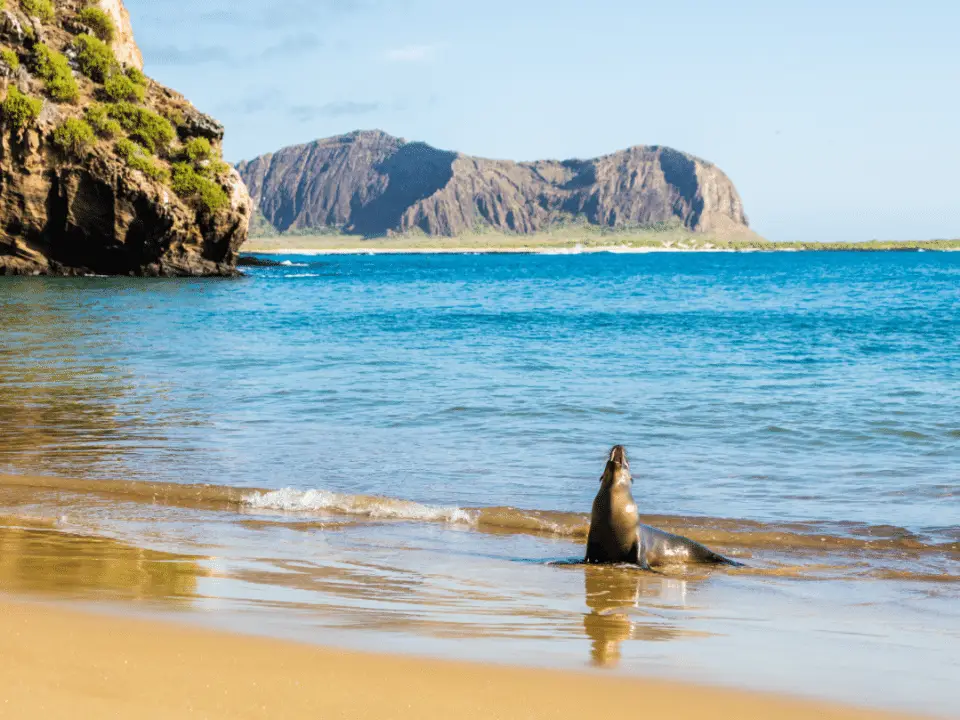
Galapagos Hotels: Stunning Places to Stay for a Unique Adventure
April 25, 2025Ecuador Galapagos Islands offer a unique travel experience that captivates adventurers and nature enthusiasts alike. With its stunning landscapes, remarkable biodiversity, and rich cultural heritage, the Galapagos archipelago stands as an unforgettable destination for international travelers in 2025. This article explores why these islands should be on your travel itinerary, highlighting their unique features and attractions.
Table of Contents
Why Visit Ecuador Galapagos Islands in 2025?
Unique Biodiversity
The Ecuador Galapagos Islands are often hailed as one of the planet’s most extraordinary ecosystems. Home to species found nowhere else on Earth, such as the famous giant tortoises and blue-footed boobies, these islands were pivotal in shaping Charles Darwin’s theory of evolution. When you walk along the trails or snorkel in the crystalline waters, you’ll encounter wildlife that has evolved without fear of humans. This absence of natural predators allows for close interactions with animals like playful sea lions and curious marine iguanas.
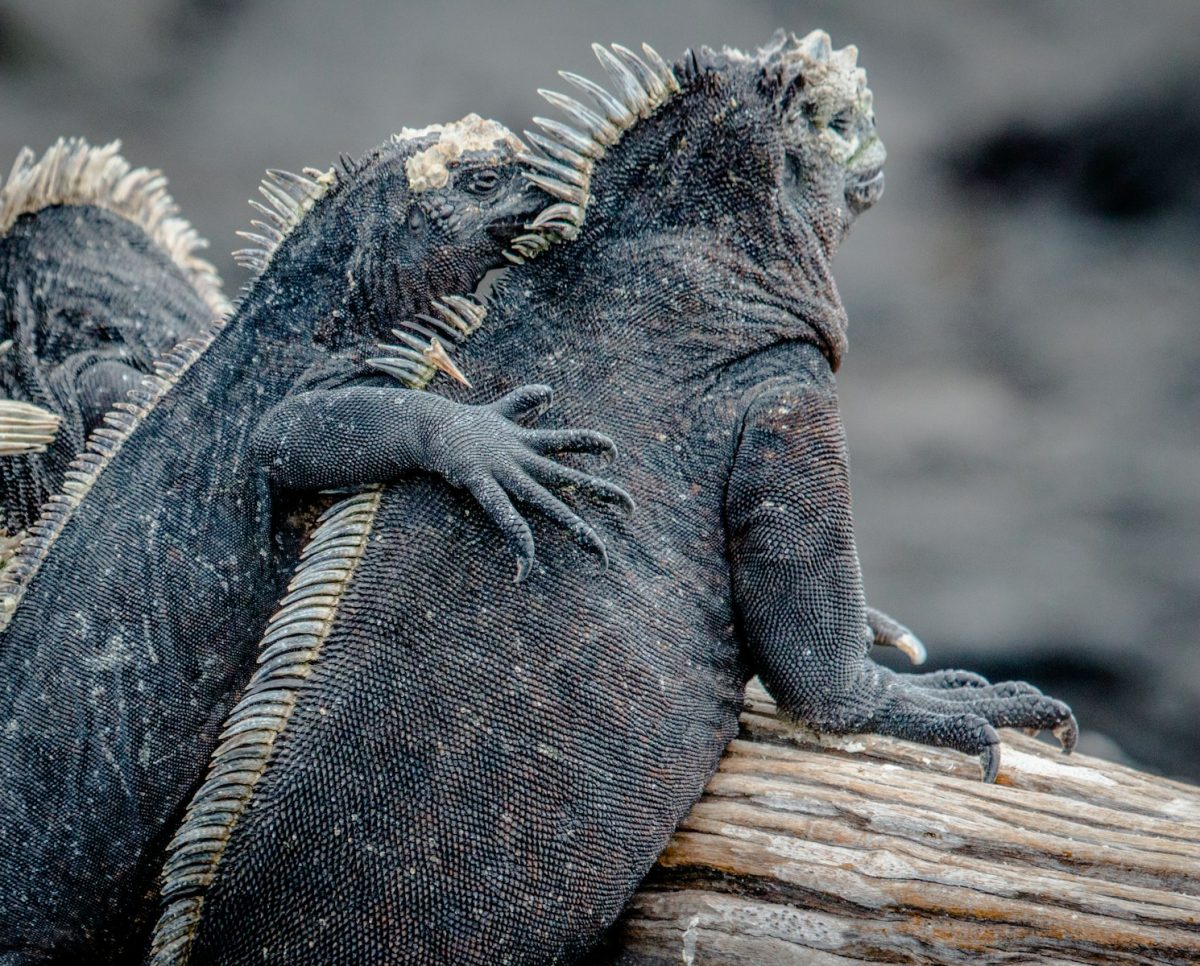
The islands boast a collection of unique habitats ranging from lush highlands to arid coastal zones. Each island hosts its own distinct community of flora and fauna, making every visit an exploration into nature’s marvels. As stated by Metropolitan Touring, “A journey to the Galapagos Islands is a journey to a land before time,” emphasizing how untouched these islands remain despite their popularity among tourists.
Ideal Climate for Travel
Another reason to plan your trip to the Ecuador Galapagos Islands in 2025 is their ideal climate year-round. Thanks to their location along the equator, visitors can enjoy pleasant weather irrespective of when they choose to visit. The hot season from December through May sees calmer seas and vibrant vegetation due to intermittent rainfall, which nurtures flourishing plant life across the islands.
Conversely, from June until November, cooler temperatures dominate the dry season while still offering ample opportunities for adventure. During this period, nutrient-rich upwellings draw marine life closer to shore—perfect for snorkeling or diving excursions that showcase vibrant coral reefs teeming with colorful fish. With minimal fluctuations in climate throughout the year, planning your dream getaway becomes even easier!
Top Attractions in Ecuador Galapagos Islands
The Enigmatic Charles Darwin Research Station
A visit to the Charles Darwin Research Station is an absolute must when exploring these islands. Located on Santa Cruz Island, this research facility plays a crucial role in conservation efforts aimed at preserving endemic species like giant tortoises and land iguanas. Visitors can witness firsthand how conservationists nurture tortoise hatchlings before releasing them back into their natural habitats.

The station also serves as an educational hub where travelers can learn about ongoing environmental initiatives and get involved through volunteer opportunities or guided tours led by knowledgeable staff members. According to information from GalapagosIslands.com, “you will experience not only breathtaking scenery but also understand more profound ecological issues.” It’s a fantastic way to enrich your trip while supporting vital conservation work.
Breathtaking Snorkeling at Devil’s Crown
For those seeking aquatic adventures during their stay at the Ecuador Galapagos Islands, snorkeling at Devil’s Crown should be high on your list! This submerged volcanic caldera offers unparalleled underwater experiences rife with diverse marine life—from vibrant schools of fish darting around you to majestic sea turtles gliding gracefully through crystal-clear waters.
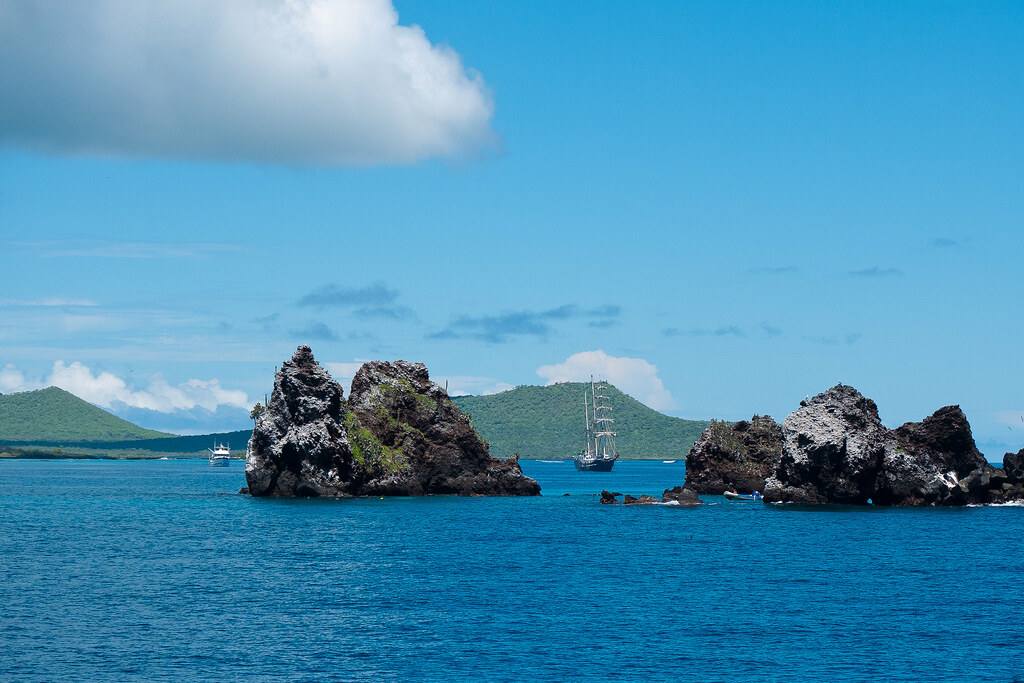
Situated near Floreana Island, Devil’s Crown is recognized as one of the best snorkeling spots globally due to its abundant coral formations and thriving ecosystems; it’s truly akin to swimming inside nature’s aquarium! Whether you’re an experienced snorkeler or just starting out, this spot promises awe-inspiring encounters that create lasting memories—just don’t forget your waterproof camera!
Exploring the Unique Flora and Fauna of Española Island
Española Island provides yet another incredible opportunity for wildlife observation within Ecuador’s Galapagos Islands landscape! Home to numerous endemic species—including waved albatrosses during mating season—the island showcases astonishing biodiversity against dramatic cliffs and pristine beaches.
Visitors can embark on guided hikes across rugged terrain while observing various bird species nesting among striking coastal features like blowholes—natural wonders shooting seawater into arcs above rocky shores! The island also hosts marine iguanas basking under warm sun rays alongside colorful sally lightfoot crabs scuttling over lava rocks—a true testament to evolution adapting wildlife uniquely suited for survival here.
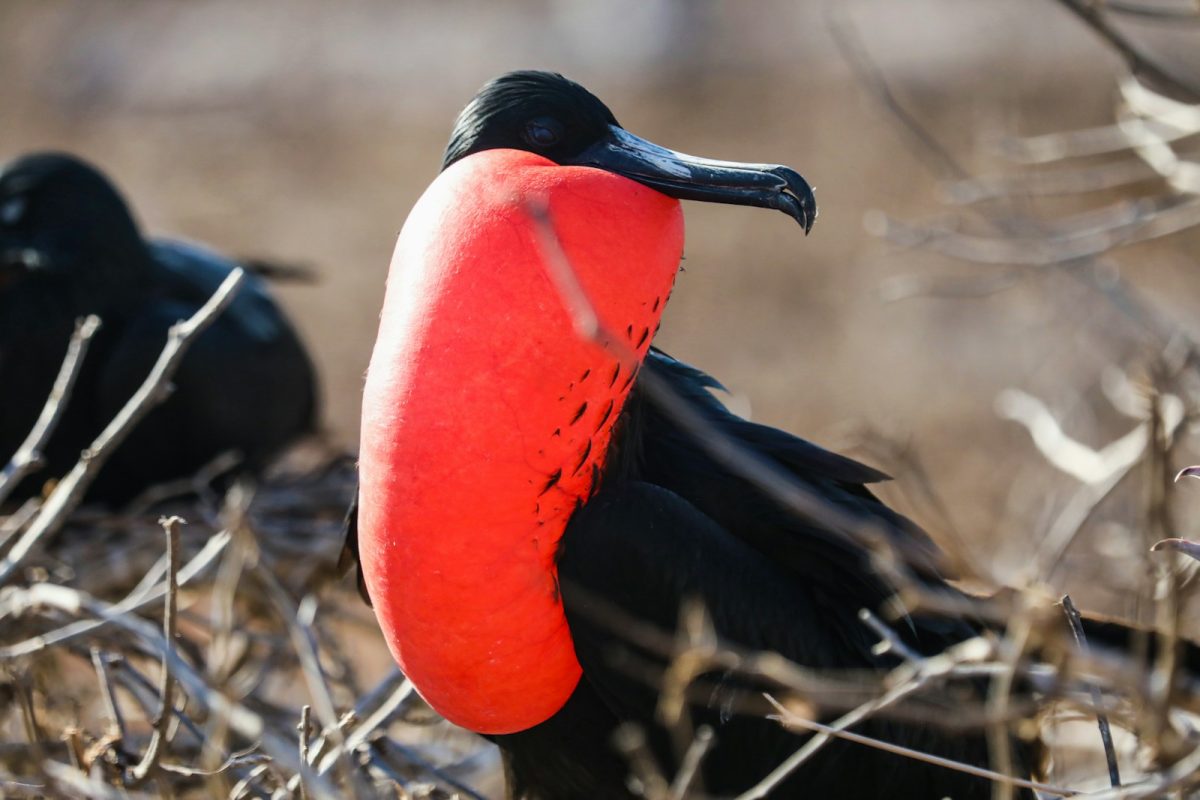
In addition to hiking trails leading through rich vegetation filled with exotic plants native solely here (such as its famous yellow daisy), Española offers plenty of stunning views perfect for photographers looking forward capturing picturesque landscapes amidst undisturbed beauty!
| Attraction | Highlights | Best Time To Visit |
|---|---|---|
| Charles Darwin Research Station | Conservation efforts & adult giant tortoises | Year-round |
| Devil’s Crown | World-class snorkeling with diverse marine life | December-May (hot season) |
| Española Island | Endemic bird species & striking landscapes | April-December (mating season) |
In summary, visiting Ecuador’s Galapagos Islands promises experiences like no other—unique biodiversity combined with breathtaking attractions make it an unforgettable destination worth exploring in 2025!
Adventure Activities in Ecuador Galapagos Islands
Kayaking Through Pristine Waters
Kayaking in the Ecuador Galapagos Islands is an absolute must-do for adventure seekers. Picture yourself paddling through crystal-clear waters, surrounded by stunning volcanic landscapes and abundant wildlife. As you glide along the coasts, keep an eye out for playful sea lions and schools of colorful fish swimming beneath your kayak.
The tranquility of the lagoons, often dotted with mangroves, offers a unique perspective on the islands’ rich biodiversity. You might even catch sight of nesting birds perched above—the perfect moment for that Instagram shot! Many tours offer guided kayaking excursions where experienced naturalist guides share insights about the local ecosystems while ensuring a safe and immersive experience.
Hiking the Scenic Trails of Sierra Negra Volcano
For those who prefer to explore on foot, hiking up Sierra Negra Volcano is an unforgettable adventure. Standing at over 1,490 meters (4,888 feet), this volcano boasts one of the largest craters in the world—an impressive sight that leaves visitors in awe. The hike can be challenging but rewards you with breathtaking views overlooking lush highlands and neighboring islands.
As you trek along well-marked paths surrounded by unique flora and fauna, take time to appreciate the diverse ecosystems that flourish here. From giant tortoises to endemic bird species like the Galapagos mockingbird, every step brings new opportunities for wildlife observation. Plus, don’t forget your camera—the vistas from above are simply stunning!
Diving with Sharks and Rays
Diving in the Ecuador Galapagos Islands is renowned as some of the best worldwide—and for good reason! The underwater world is vibrant with life; expect to encounter majestic hammerhead sharks gliding gracefully through blue waters alongside curious eagle rays and playful sea lions eager to join you on your dive.
Many diving operators cater to various skill levels, offering everything from beginner courses to advanced dives into deeper waters teeming with marine life. The Galapagos Marine Reserve hosts an array of diving spots such as Darwin Island and Wolf Island—both famous for their rich biodiversity and exhilarating marine encounters.
Cultural Experiences in Ecuador Galapagos Islands
Meeting Local Communities
Beyond its incredible wildlife, visiting local communities in the Ecuador Galapagos Islands enriches your travel experience immeasurably. Spend time interacting with residents who embody vibrant island culture while sharing stories about daily life shaped by their surroundings.
Community-led initiatives often provide tourists with authentic cultural experiences such as artisanal workshops or cooking classes featuring traditional dishes made from local ingredients like fresh seafood or tropical fruits. Engaging directly with locals not only enhances your understanding of island life but also supports sustainable tourism practices that benefit these close-knit communities.
Understanding Conservation Efforts
The conservation efforts within the Ecuador Galapagos Islands are commendable and crucial to preserving this unique ecosystem. With around 97% of its land designated as national parkland, strict regulations ensure that both visitors and locals protect these fragile environments.
Participating in guided tours led by certified naturalists allows travelers to learn about ongoing conservation projects aimed at preserving endangered species like giant tortoises or marine iguanas. Additionally, many organizations offer volunteer opportunities where visitors can contribute directly to conservation work—making not just memories but also meaningful impacts during their stay.
Savoring Traditional Cuisine
No trip would be complete without indulging in delicious local cuisine! In towns like Puerto Ayora on Santa Cruz Island or San Cristobal’s capital city, you’ll find cozy eateries serving fresh seafood delicacies caught daily from surrounding waters. Don’t miss trying ceviche—a zesty dish featuring marinated fish tossed with lime juice mixed with onions and cilantro—as it captures both flavor and freshness typical of Ecuadorian coastal fare!
For those seeking something sweet after a meal—or just looking for a snack—try empanadas or bolón de verde (a savory plantain ball filled with cheese). Many restaurants also incorporate locally sourced ingredients into traditional recipes while showcasing flavors reflective of both indigenous heritage and contemporary culinary art forms.
Travel Tips for Ecuador Galapagos Islands in 2025
Best Time to Visit
When planning your trip to Ecuador Galapagos Islands in 2025, consider visiting either during dry season (June-November) or hot season (December-May). Both seasons offer distinct advantages: during dry season cooler temperatures promote fantastic snorkeling conditions due to nutrient-rich water attracting diverse marine life; conversely hot season features blooming landscapes ideal for photo ops amidst lush greenery!
However, since wildlife sighting varies throughout months regardless of climate patterns—plan ahead based on personal preferences regarding activities such as breeding seasons among iconic species like blue-footed boobies which peak between April-December!
| Season | Characteristics | Best Activities |
|---|---|---|
| Dry | Cool temperatures & less rain | Snorkeling & Wildlife Observation |
| Hot | Warm weather & blooming flora | Hiking & Beach Days |
Packing Essentials for Your Trip
Packing smartly ensures you’re prepared for all adventures awaiting you on this enchanting archipelago! Essential items include lightweight clothing suitable for warm weather while keeping sun protection top-of-mind: think breathable fabrics paired together with wide-brimmed hats plus sunscreen (high SPF recommended).
Don’t forget swimwear if you plan to snorkel or dive into those mesmerizing turquoise waters! Comfortable footwear like water shoes will make beach days enjoyable too—every step counts when exploring sandy shores or rocky trails alike.
Lastly bring binoculars/cameras along so nothing goes unseen—from rare bird sightings high above down below where playful sea lions frolic nearby!
Navigating the Islands: Transportation Options
Getting around Ecuador Galapagos Islands varies depending upon whether opting land-based experiences staying at hotels/lodges versus cruising aboard expedition vessels exploring multiple islands by sea instead!
For those selecting land-based routes typically travel via small boats known as pangas between various visitor sites though limited access exists compared against what cruise itineraries cover conveniently overnight sailing across different locations maximizing exposure across diverse landscapes throughout archipelago’s vast expanse!
Meanwhile guests aboard cruises enjoy seamless transitions moving from one destination another effortlessly—all organized through experienced crews ensuring each day spent soaking up island wonders becomes memorable without hassles associated navigating logistics independently.
Accommodations in Ecuador Galapagos Islands
Luxury Resorts with Stunning Views
For travelers seeking indulgence, the Ecuador Galapagos Islands offer a selection of luxury resorts that provide breathtaking views and top-notch amenities. One standout is the Finch Bay Galapagos Hotel, renowned for being the only beachfront property on Santa Cruz Island. Guests can enjoy direct access to pristine beaches while also indulging in gourmet dining experiences that highlight local ingredients.
Another excellent option is the Pikaia Lodge, located on Santa Cruz Island. This eco-friendly resort features modern design blended with natural beauty, offering spectacular views of the surrounding landscapes and wildlife. The lodge prides itself on sustainable practices, allowing visitors to unwind without compromising their environmental values.
| Resort Name | Key Features |
|---|---|
| Finch Bay Hotel | Beachfront access, gourmet dining |
| Pikaia Lodge | Eco-friendly design, stunning landscape views |
These luxurious accommodations ensure that your stay in the Ecuador Galapagos Islands is as comfortable as it is unforgettable.
Eco-Friendly Lodges for Sustainable Travel
Sustainability is at the forefront of many travel choices today, and luckily, the Ecuador Galapagos Islands have several eco-lodges committed to preserving this unique environment. For example, the Red Mangrove Inn provides guests with not just comfort but also immersive nature experiences. Located near Puerto Ayora, it offers guided excursions focusing on wildlife conservation and education about local ecosystems.
Similarly, Tortuga Bay Lodge emphasizes sustainable tourism by using solar energy and supporting local communities through cultural exchanges and tours. Staying at these lodges allows travelers to experience the islands while minimizing their ecological footprint.
| Eco-Lodge Name | Sustainability Initiatives |
|---|---|
| Red Mangrove Inn | Guided excursions focused on conservation |
| Tortuga Bay Lodge | Solar energy use & community support |
Choosing eco-friendly options helps ensure that future generations can enjoy the magic of this archipelago too.
Budget-Friendly Hostels and Guesthouses
Traveling to paradise doesn’t have to break the bank! For budget-conscious adventurers heading to the Ecuador Galapagos Islands, there are plenty of hostels and guesthouses available. Places like La Posada del Mar offer cozy accommodations without sacrificing quality or service. With friendly staff ready to assist you in planning your activities, it’s an ideal base for exploration.
Hostal Isla de la Plata presents another affordable choice where you can meet fellow travelers while enjoying shared facilities like kitchens that allow you to save money by preparing some meals yourself. These budget-friendly options keep you connected with other travelers while providing easy access to nearby attractions.
| Accommodation Type | Average Cost per Night (USD) |
|---|---|
| La Posada del Mar | $30-$60 |
| Hostal Isla de la Plata | $20-$40 |
With various options available across price ranges, visiting these stunning islands can be both enjoyable and economical.
Wildlife Encounters in Ecuador Galapagos Islands
‘Giant Tortoises: The Living Fossils’
When one thinks about iconic wildlife in the Ecuador Galapagos Islands, giant tortoises immediately come to mind! Known as living fossils due to their ancient lineage dating back over 100 million years, these gentle giants symbolize conservation efforts within the archipelago.
Visitors often head to places like Charles Darwin Research Station where they can learn about ongoing breeding programs aimed at restoring populations decimated by human activity. Spotting these majestic creatures lumbering across lush highlands or basking under sunlit trees remains a bucket-list experience for many adventurers!
‘Blue-Footed Boobies: Nature’s Clowns’
The blue-footed booby is another must-see species when visiting the Ecuador Galapagos Islands—often deemed “nature’s clowns” due to their comical courtship dances performed during mating season! Their vibrant blue feet serve as an attraction mechanism; males display them proudly while performing impressive aerial dives into waters teeming with fish.
Photographers love capturing these quirky birds either perched gracefully along cliffs or diving dramatically below ocean waves—truly a sight worth watching! Observing their antics adds layers of joy during island explorations or snorkeling adventures around vibrant marine life hotspots.
‘Marine Iguanas: The Only Sea-Loving Lizards’
Unlike any other lizard species worldwide, marine iguanas are uniquely adapted for life by sea! These remarkable reptiles swim proficiently through saltwater—feeding primarily on algae found along rocky shorelines throughout various islands of this archipelago!
While sunbathing atop lava rocks or navigating coastal waters effortlessly during feeding frenzies showcases how well suited they are for their habitat; visitors should take care not disturb these fascinating creatures so close up encounters remain safe yet thrilling!
Wildlife Observation Tips:
- Keep a respectful distance from all animals.
- Bring binoculars for better viewing.
- Follow guidelines provided by Naturalist Guides.
‘Ecuador Galapagos Islands’ Conservation Efforts and Challenges’
‘Protecting Endemic Species’
Conservation efforts in the Ecuador Galapagos Islands focus heavily on protecting endemic species native only to this region—including giant tortoises mentioned earlier! Initiatives led by organizations like Fundación Charles Darwin aim not just at rehabilitation but also promoting awareness regarding habitat preservation among locals and tourists alike.
Strict regulations govern interactions between visitors and wildlife populations; entering national park areas requires accompaniment from certified guides who understand how best protect delicate ecosystems from potential harms posed by increased human foot traffic!
Key Conservation Programs:
- Breeding programs for endangered species (e.g., giant tortoises).
- Educational workshops targeting sustainable practices.
- Habitat restoration projects promoting biodiversity balance.
‘Sustainable Tourism Initiatives’
Sustainable tourism plays a crucial role in protecting both natural resources within this UNESCO World Heritage site whilst ensuring economic benefits flow back into local communities directly reliant upon responsible travel habits fostered here!
From ecotourism lodgings prioritizing environmental stewardship alongside community engagement opportunities down through organized tours emphasizing low-impact activities such as hiking rather than motorized transport—these strategies help minimize visitors’ carbon footprints significantly compared against traditional vacation models elsewhere around world!
Examples Include:
- Tour operators offering educational experiences about marine protection.
- Local artisans selling ethically sourced souvenirs that contribute directly toward preservation funding initiatives.
Visitors can feel good knowing each step taken contributes positively towards long-term viability surrounding delicate environments thriving amidst captivating landscapes encountered throughout journey across varied islands!
‘Addressing Environmental Threats’
Despite active conservation efforts underway within Ecuadors’ famed archipelago challenges persist relating especially invasive species threatening native flora/fauna ecosystems alike! Feral goats pose an immediate risk consuming vegetation vital sustaining indigenous animal life forms; thus management tactics include culling populations along designated zones where necessary whilst gradually restoring balance achieved via replantings native plant varieties historically present prior human interference occurred over centuries past .
Also rising sea levels attributed climate change poses significant issues facing island communities requiring adaptation measures proactively engaged before detrimental effects manifest severely impacting habitats overall viability moving forward into future generations’ enjoyment possibilities contained therein same mesmerizing vistas experienced today !
Through collaborative actions among government agencies NGOs scientists dedicated volunteers passionate individuals working together tackling critical issues ensures continued success preserving incredible biodiversity found nowhere else planet Earth nor easily replicated elsewhere globally .
Frequently asked questions on Ecuador Galapagos Islands
What makes the Ecuador Galapagos Islands a unique travel destination?
The Ecuador Galapagos Islands are renowned for their extraordinary biodiversity, featuring species that can’t be found anywhere else on Earth. The islands played a significant role in shaping Charles Darwin’s theory of evolution, making them a fascinating destination for nature enthusiasts and adventure seekers alike.
When is the best time to visit the Ecuador Galapagos Islands?
The ideal times to visit the Ecuador Galapagos Islands are during the dry season from June to November or the hot season from December to May. Each season offers unique experiences: cooler temperatures and fantastic snorkeling conditions during the dry season versus lush landscapes and vibrant vegetation in the hot season.
What are some must-see attractions in the Ecuador Galapagos Islands?
Charles Darwin Research Station, where visitors can learn about conservation efforts; Devil’s Crown, known for world-class snorkeling; and Española Island, famous for its endemic wildlife and stunning landscapes. Each location provides unforgettable experiences that highlight the islands’ natural beauty.
How can travelers support conservation efforts while visiting Ecuador Galapagos Islands?
Travelers can support conservation by participating in guided tours led by certified naturalists, engaging with local communities, and staying at eco-friendly accommodations. Many organizations also offer volunteer opportunities that allow visitors to contribute directly to ongoing conservation projects aimed at preserving this unique ecosystem.
What wildlife can I expect to see in the Ecuador Galapagos Islands?
You can expect to encounter iconic species such as giant tortoises, blue-footed boobies, and marine iguanas. The islands provide excellent opportunities for wildlife observation due to their unique ecosystems that have evolved without fear of humans.
Are there any specific activities recommended for adventure seekers in Ecuador Galapagos Islands?
Absolutely! Adventure seekers should consider kayaking through pristine waters, hiking up Sierra Negra Volcano for breathtaking views, or diving with sharks and rays in some of the world’s best dive spots like Darwin Island and Wolf Island.
Is it possible to experience local culture while visiting Ecuador Galapagos Islands?
Yes! Visitors can engage with local communities through artisanal workshops, cooking classes featuring traditional dishes, and community-led initiatives that promote authentic cultural experiences while supporting sustainable tourism practices.
What types of accommodations are available in Ecuador Galapagos Islands?
The Ecuador Galapagos Islands offer a range of accommodations from luxury resorts with stunning views like Finch Bay Hotel and Pikaia Lodge to budget-friendly hostels such as La Posada del Mar. Eco-lodges focused on sustainability are also available for those looking to minimize their ecological footprint while enjoying their stay.

